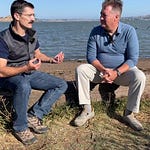This week, I talked to Dr. Michael Harman, an executive advisor, and consulting partner at Harmon Consulting about commercializing medical diagnostics, exploring various aspects from technology development to market trends and the integration of different scientific disciplines.
I asked Michael about the process of transitioning laboratory technology into clinically viable products. He described a series of well-defined steps, starting from concept generation to prototyping and feasibility testing, eventually leading to a minimally viable product ready for market launch. It starts with identifying a gap in the market and scouting relevant technologies.
Scouting is the process of identifying existing technologies that can be utilized to construct different subsystems of the proposed diagnostic tool. He used the analogy of assembling Lego pieces. While innovation can add value and is, of course, a little more exciting, it also increases risk.
The engineering process of diagnostics involves bringing together various fields like industrial design, electrical and mechanical engineering, and crucial business aspects like sales and marketing.
I didn’t know much about the world of diagnostics that lies between lateral flow tests like the ones we all use for COVID-19, and large analyzers running thousands of samples per day delivering results of multiple assays to your doctor.
Michael noted a significant shift from centralized laboratory instruments to more compact, point-of-care devices, largely influenced by the COVID-19 pandemic. He highlighted the growing trend towards personalized medicine and home testing kits, demonstrating the evolution of diagnostic technology in response to global health challenges.
This got me curious about the role of electrical engineering in diagnostics. So we took a little sidebar into the intricacies of technologies like thermocyclers for PCR. While heating a metal block seems straightforward, doing so evenly across 96 samples may not be. And I never put much thought into what it takes to cool that block quickly and where the heat needs to go. Needless to say, I have a new appreciation for electrical engineering beyond circuits and robotics.
A key takeaway from our conversation was the integration of various scientific disciplines, such as computer science, biology, and physics, in developing new diagnostic methods. He mentions several innovative diagnostic projects he's involved in, such as non-invasive tests for endometriosis and personalized contraception compatibility tests. These projects exemplify the potential of predictive diagnostics to revolutionize patient care and treatment.
There have been significant strides made in this field, largely due to the collaboration across different scientific domains. He emphasizes the importance of bioinformatics and the role of computer science in medicine, marking a paradigm shift in how medical research and diagnostics are approached. It also presents challenges:
People don't always necessarily know what to do with diagnostic information either. That is a big challenge in terms of, okay, great. You've identified a marker now exists, but what is that now? How do you then inform the patient of or change their treatment based on that information?
If you find this helpful, it kind of makes sense to subscribe, doesn’t it?
Thanks for spending some time here, either way.
As we often do, we discussed the challenges faced by academic founders in transitioning their ideas from academia to industry and the mindset changes required for successful commercialization. He notes that while academics are used to being highly independent and handling various aspects of a project, success in the industry often requires a more collaborative approach. Founders must learn to trust and leverage their teams, allowing each member to contribute their expertise to the project.
Michael mentions the debate about the necessity of having clinicians or scientists in leadership roles in medical companies. While their deep understanding of the technology is beneficial, it can also be challenging for them to step back and allow others to handle aspects of the business they are less familiar with. This transition, from being an independent academic to a team-oriented industry leader, is crucial for the successful commercialization of medical technologies.
Our conversation shed light on the complexities of commercializing medical diagnostics and highlighted the importance of interdisciplinary collaboration in driving innovation in this field.
Your deepest insights are your best branding. I’d love to help you share them. Chat with me about custom content for your life science brand. Or visit my website.













